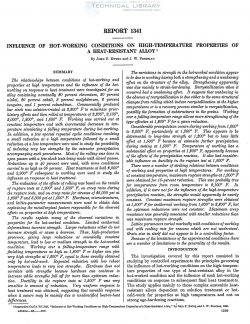naca-report-1341
- Version
- 213 Downloads
- 3.95 MB File Size
- 1 File Count
- November 2, 2016 Create Date
- November 2, 2016 Last Updated
National Advisory Committee for Aeronautics, Report - Influence of Hot Working Conditions on High Temperature Properties of a Heat Resistant Alloy

The composition of the particular alloy used was nominally
0.15 percent carbon, 20 percent chromium, 20 percent nickel,
20 percent cobalt, 3 percent molybdenum, 2 percent tung-
sten, 1 percent columbium, and the balance iron. Working
was carried out at several constant temperatures to define
the influence of amount of reduction at a given temperature.
Specific reductions at specific temperatures over a range of
decreasing temperatures were used to study the influence
of the usual working over a falling-temperature range.
Additional limited studies were made to establish the effects
of possible heating and working schedules involving reheats
to temperatures below and in the resolution range with
reductions at low temperatures where extensive precipitation
occurs. In addition, samples were given typical final
solution, solution and aging, and solution and hot-cold-
working treatments for the purpose of studying the effects
of prior working on response to heat treatment.
At least two general factors influence the properties at
high temperatures of individual alloys of the type investi—
gated. First, various final treatments may be used to obtain
specific properties. These can range in wrought products
from the hot-worked condition with no subsequent treat-
ment through so-called stress-relieving, solution treatments
at various temperatures with or without subsequent aging
treatments and, for the type of alloy considered, possibly
cold—work or hot-cold—worldng operations after the other
treatments. The other general factor leading to variability in
properties arises from the variation in properties with specific
final treatments. Recognized possible sources of the latter
type of variation include the influence of conditions of hot-
working on the response to final treatments, variations in
chemical composition, and unidentified heat—to-heat difi’er—
ences.
Properties in the hot-worked condition are considered to
be difficult to control. Practical limitations in the repro-
ducibility of conditions of working as well as lack of informa-
tion regarding the influence of the conditions of working
are involved. It is known that both very high and very low
strengths as well as intermediate values of strength are
observed in hot-worked products not subjected to further
treatment. No completely reliable means of predicting the
level of properties was available. Certainly microstructure
or hardness and other normal short-time mechanical—property
tests do not reliably predict creep and rupture values. No
information was available regarding the influence of amount
and temperature of reduction on properties. Likewise,
there was no good information on the degree of influence
of the hot-working conditions on response to the usual final
treatments as reflected in the property ranges for a specific
final treatment
Extensive previous studies had been carried out for the
National Advisory committee for Aeronautics on the same
alloy as that used for the present investigation to establish
the influence of various types of treatment on the properties
at high temperatures.
| File | Action |
|---|---|
| naca-report-1341 Influence of Hot Working Conditions on High Temperature Properties of a Heat Resistant Alloy.pdf | Download |

Comment On This Post